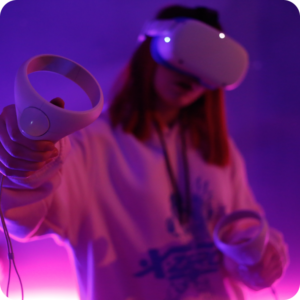Five in Five
Five key facts at a glance!
- The metaverse idea is still being defined but is being punted as allowing an immersive experience in a completely hybrid version of our real surroundings and multiple virtual worlds.
- Virtual Reality (VR) and Augmented Reality (AR) are existing enabling technologies with substantial differences that help to enrich the user’s digital experience.
- The billion-dollar computer gaming industry with its millions of users has been responsible for the first investments in and developments of the metaverse, followed by the fashion industry which has also been exploiting NFT technology.
- If technology, connectivity and power facilities evolve sufficiently, a form of metaverse could provide interesting opportunities for CFOs to conduct successful scenario planning and R&D across multiple domains.
- At a financial level, it will offer the possibility to make data-driven AI-supported decisions enhanced by realistic, real-time simulations that may help save your company both time and money.
The “metaverse” is the name for a concept encompassing all the cutting-edge technologies available today – and many that are still to be invented. It is being sold as the evolution of the internet: a combination of a virtual space and a digitally enhanced version of reality where people interact, socialize, play, learn, and trade.
Its earliest version is arguably to be found in today’s video-gaming worlds, picture Fortnight, World of Warcraft, or Second Life, but its supporters and promoters claim it has immense potential for business, R&D, and education as well as for other areas that we cannot yet fully imagine.
According to research conducted by McKinsey in June 2022 among 3,400 consumers, executives and senior leaders, the metaverse will be both a “digital playground” and a “commercial space” that could generate up to $5 trillion in value by 2030. And it is this potential that is attracting the attention of technology companies, business leaders and consumers.
While the technology, processing ability, and power to create a hybrid space that fully integrates our everyday interactions with a digitally augmented virtual reality do not currently exist, metaverse fans claim that many essential enabling technologies such as artificial intelligence (AI), virtual reality (VR), augmented reality (AR), and the blockchain are now converging to make the metaverse possible.
Futurists and pioneers are unclear on exactly how the metaverse concept will evolve, if it will at all in the form in which it is currently being promoted. However, it is safe to assume that certain elements of the concept may well concretize and develop in the near future.
So what potential applications does the concept have for the business sector and, above all for CFOs, what is the potential of the metaverse for the financial sector?
Where did the metaverse concept arise?
The term itself was coined by science fiction author Neal Stephenson in his 1992 book Snow Crash that by many accounts heavily influenced technology developers in Silicon Valley. Stephenson presented the metaverse as a type of massively multiplayer online game accessed via terminals in which people interact as avatars.
This inspired certain definitions of the metaverse as a three-dimensional digital space that uses the most advanced technologies, including VR and AR to give people personal and realistic experiences in a fully online world.
The gaming industry continues creating increasingly sophisticated digital worlds and the evolution of the metaverse concept was further stimulated by the enormous success of DJ Marshmello’s concert within the Fortnite platform in 2019. Similar events held during the pandemic lockdowns fanned the flames, while the successful sale of avatar outfits, virtual weapons, supplies and equipment, and game shortcuts to gamers within the gaming platforms catalysed interest in the virtual retail and commercial opportunities. Since these digital gaming worlds currently host over 3 billion people worldwide, the possible commercial significance for opportunistic companies is easy to understand.
The characteristics of immersivity and real-time interactivity are key elements of the metaverse concept, whose most comprehensive form includes:
- platforms and devices working seamlessly with each other across physical geographies
- multiple thousands of people interacting simultaneously with each other, these digital worlds and their own physical surroundings
- and, as we anticipated, use cases that go far beyond gaming
According to its promoters, the metaverse concept should be seen as a utopia that augments reality with content, community and virtual experiences that make us feel more connected, more productive at work and happier.
Detractors on the other hand cite exponentially larger problems with privacy issues resulting from indiscriminate collection of data about users’ activities, the likelihood of increased social problems of digital dependency, isolation and escapism from the real world, and the exclusion of whole groups of people such as those with limited or no sense of sight, as well as the security and safety issues for vulnerable groups (read sexual grooming of minors, digital stalking, cyber bullying, and similar activities, just for starters).

Differences between AR and VR
Key enabling technologies for immersive participation in the metaverse, Virtual Reality (VR) and Augmented Reality (AR) are often confused with each other but differ both in cost and application.
Both are punted as having significant potential beyond gaming and simulation, for marketing, e-commerce, education and scenario planning. While the technology has improved and the costs have fallen, VR has yet to achieve mass adoption worldwide despite significant marketing efforts by multitudes of companies. Some experts suggest this may be as a result of the unique form of motion-sickness-type nausea dubbed “cybersickness”, or the related neck pain and general discomfort all tied to frequent and extended use of these headsets.
There are some significant differences between VR and AR:
- Augmented Reality refers to information that is ‘added’ to a real image using a computer-connected camera and a network of sensors.
Today’s technology has enabled the necessary hardware and software to be enclosed inside a portable device such as a smartphone or tablet, or wearable technology (such as glasses).
AR transforms the physical world into a digitally enhanced world visually, by projecting virtual images and characters onto the user’s view of the real world, enhancing the user’s real-life experience.
AR has already enabled some life-saving operations: on 21 February 2020 doctors in Mexico performed surgery using transparent holographic lenses with great success.
- Virtual Reality on the other hand, replaces reality with a computer-generated alternative world that requires the user to wear special visors or goggles or use a monitor to view this 3D simulation as well as the use of special equipment such as sensors, gloves or gaming controllers to interact with it.
Each technology offers advantages and disadvantages for business or industrial applications. With AR you remain in your physical reality while engaging with digital 3D projections; VR immerses you in another reality that may often be more suitable for certain applications, such as specific training purposes.

From gaming and fashion…
As already mentioned, gaming fuelled most of the early ideas concerning the potential of the metaverse concept while its growth as an industry (outstripping film and music) has whetted commercial appetites:
- Roblox recorded more than 58 million daily active users in 2022
- Fortnite surpassed 20 million users in 2020 and generated more than $9 billion in sales between 2018 and 2019
- Minecraft has 170 million active users
- Meta (previously Facebook) continues to spend at least $10 billion a year on developing its concept of the metaverse.
Fashion is also driving innovation in the virtual space. Likely originating from the success of the sale of “skins” in gaming platforms to allow gamers to personalize their avatars, the fashion world has keenly adopted the virtual space, using it to host fashion shows and launch both real and virtual collections.
Blockchain technology enabled the creation of NFTs, or non-fungible tokens, which certify the authenticity and ownership of digital assets. Combined with cyber currencies, this paved the way for the monetization of virtual creations and the ability to trade them.

…to the business world!
Some experts believe that part of the urgency behind the evangelization of the metaverse is that technology companies urgently require new ways to generate revenue as the markets for smartphones, PC technologies, and software apps have become saturated.
It must be said, however, that some sectors are discovering concrete uses for certain aspects of the metaverse. Simulation engineers are finding it useful for modelling technological product enhancements and improvements in simulated realities to better observe and interpret design changes and their consequences. Manufacturers find virtual reality constructs useful for training operators in the use of new machinery without wasting production runs.
Faced with increasing levels of geopolitical risk and complexity and their multiple potential consequences, CEOs and CFOs are having to prepare for a wider variety of potential scenarios to safeguard the security and success of their companies by foreseeing and mitigating against both supply-side and demand-related risks. Metaverse-inspired simulation environments enhanced with data-based artificial intelligence can allow them to explore all potential what-if scenarios in more realistic and comprehensive ways.

Future possibilities for the financial world
Large organizations are already investing significantly in the financial industry of the future, and there is already mention of a financial metaverse.
As we have suggested, there are possibilities for CFOs and accounting departments to exploit aspects of the metaverse for forecasting, risk analysis, and training and skills development.
Another area is the use of metaverse-inspired simulations to explore all the potential cyber security risks that could emerge as a result of the implementation of new technologies.
It could be used to allow the finance department to collaborate with other departments, such as sales and marketing, to create engaging and interactive 3D financial models and simulations to enable more informed decision making.
Metaverse-type digital representations of an organization’s financial data, such as balance sheets, income statements, and cash flows could be used to provide CFOs and accounting departments with a 3D view of their financial KPIs and allow them to interact with their business analytics for business development and strategizing, enabling them to explore the organization’s performance and better prepare for possible opportunities and potential risks.





